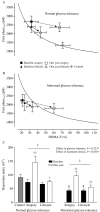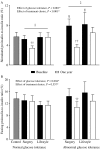Beta cell function after weight loss: a clinical trial comparing gastric bypass surgery and intensive lifestyle intervention
- PMID: 21078684
- PMCID: PMC3022337
- DOI: 10.1530/EJE-10-0804
Beta cell function after weight loss: a clinical trial comparing gastric bypass surgery and intensive lifestyle intervention
Abstract
Objective: The effects of various weight loss strategies on pancreatic beta cell function remain unclear. We aimed to compare the effect of intensive lifestyle intervention (ILI) and Roux-en-Y gastric bypass surgery (RYGB) on beta cell function.
Design: One year controlled clinical trial (ClinicalTrials.gov identifier NCT00273104).
Methods: One hundred and nineteen morbidly obese participants without known diabetes from the MOBIL study (mean (s.d.) age 43.6 (10.8) years, body mass index (BMI) 45.5 (5.6) kg/m², 84 women) were allocated to RYGB (n = 64) or ILI (n = 55). The patients underwent repeated oral glucose tolerance tests (OGTTs) and were categorised as having either normal (NGT) or abnormal glucose tolerance (AGT). Twenty-nine normal-weight subjects with NGT (age 42.6 (8.7) years, BMI 22.6 (1.5) kg/m², 19 women) served as controls. OGTT-based indices of beta cell function were calculated.
Results: One year weight reduction was 30% (8) after RYGB and 9% (10) after ILI (P < 0.001). Disposition index (DI) increased in all treatment groups (all P<0.05), although more in the surgery groups (both P < 0.001). Stimulated proinsulin-to-insulin (PI/I) ratio decreased in both surgery groups (both P < 0.001), but to a greater extent in the surgery group with AGT at baseline (P < 0.001). Post surgery, patients with NGT at baseline had higher DI and lower stimulated PI/I ratio than controls (both P < 0.027).
Conclusions: Gastric bypass surgery improved beta cell function to a significantly greater extent than ILI. Supra-physiological insulin secretion and proinsulin processing may indicate excessive beta cell function after gastric bypass surgery.
Figures



References
-
- Golay A, Felber JP, Dusmet M, Gomez F, Curchod B, Jequier E. Effect of weight loss on glucose disposal in obese and obese diabetic patients. International Journal of Obesity. 1985;9:181–191. - PubMed
-
- Knowler WC, Barrett-Connor E, Fowler SE, Hamman RF, Lachin JM, Walker EA, Nathan DM, Diabetes Prevention Program Research Group Reduction in the incidence of type 2 diabetes with lifestyle intervention or metformin. New England Journal of Medicine. 2002;346:393–403. doi: 10.1056/NEJMoa012512. - DOI - PMC - PubMed
-
- Sjöström L, Lindroos AK, Peltonen M, Torgerson J, Bouchard C, Carlsson B, Dahlgren S, Larsson B, Narbro K, Sjöström CD, Sullivan M, Wedel H, Swedish Obese Subjects Study Scientific Group Lifestyle, diabetes, and cardiovascular risk factors 10 years after bariatric surgery. New England Journal of Medicine. 2004;351:2683–2693. doi: 10.1056/NEJMoa035622. - DOI - PubMed
Publication types
MeSH terms
Substances
Associated data
LinkOut - more resources
Full Text Sources
Medical
Research Materials
Miscellaneous

